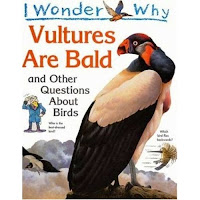As promised last Monday, I'll be sharing how we choose and use go-along books to enrich our reading experience. By using "Owl Moon" as an example, I share here three general guidelines that I use in choosing books to read together.
A GOOD MIX OF FICTION AND NON-FICTION
Just by the book's title itself, there are already two interesting topics: owls and the moon. Both are part of the natural world that can be discussed scientifically, or at least factually.
 |
So, to give us some facts about birds and owls, we read "Vultures Are Bald and Other Questions About Birds" from the I Wonder Why series, "Small Animal Encyclopedia", and "Awesome Animals: Beastly Birds and Bats." Fact books can be easily and cheaply had at any second-hand bookstore! (Should we carry these too in our shop? Hmmm.)

To know more about the moon, we read "Rookie Read-About Science: Looking Through a Telescope" that inspired us to look through our own Plan Toys toy telescope. We're still waiting for the children's grandfather to find his Time magazine-issued telescope! Oh and we also read a few pages from my husband's old Science Library book about the moon.
 |
For fun, we read more picture books! This really cool activity book, "Whoo's There? A Bedtime Shadow Book" by Heather Zschock, made us feel like there was really an owl flying over us! Whoo! Whoo!

We also read "Owl Babies" by Martin Waddell and extracted some facts about owls from the story of the scared little owls, like what they eat and when and where they sleep.
SIMILAR LITERARY FORM
"Owl Moon" as described by its author Jane Yolen, is a "gentle tone poem."
My daughter at first refused to read the book because "I don't like poems!" at that particular time. So, to appreciate poetry again, we read some more similarly written books.

Margaret Wise Brown, author of beloved "Good Night Moon," was a prolific writer who wrote hundreds of books. "Wait Till The Moon Is Full" was a perfect book to read along with "Owl Moon" as it is about a little raccoon who wants to go out at night to meet night time creatures, but is made to wait by his mother for the full moon. It contains poetic verses that the mother raccoon sings to her child.
This inspired me to sing "Owl Moon" and made Little T sit up and ask for it again and again!
The first time we read "Hiawatha" by Henry Wadsworth Longfellow, we didn't know how to feel about it. It's a looong poem. But by reading it as a go-along with other books, we learned to appreciate it over time. Reading it with "Owl Moon" made us connect with it more because both books are poems, and both are, essentially, about nature.
DEEPER LOOK AT A THEME
The girl in "Owl Moon" exhibits her self-control as she silently walks through the woods with her father - "because if you go owling, you have to be quiet." She displays why she was finally allowed to go with her father on her first owling experience.
We have actually been working on self-control for several weeks now. To go-along "Owl Moon" though, I researched on books about self-control in the Internet and came across Kevin Henkes "Lilly's Purple Plastic Purse." Borrowing Sanne's copy, we had a great time reading and talking about Lilly and how she learned to master her feelings and actions to respect her classmates and teacher. A must-read, I am getting our own copy of this book to keep!
I hope the above example has given you enough ideas to start planning go-along books with your child. It's easy and your child will soon get the hang of it and will start suggesting books to include in your list too!
Make magic!
 Blog Gadgets
Blog Gadgets




1 comment:
Yey! :) Love it! :) Want to write a similar post but I don't want to seem a "copycat"! Hahaha! :) Will share this! :) God bless!
Post a Comment